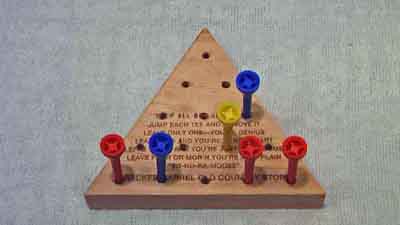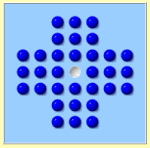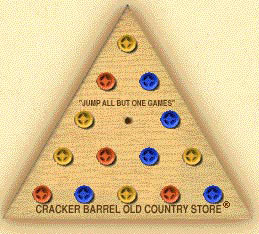
Peg Jump Puzzle

There are many different games which are called peg jump games. Peg Jump refers to a class of puzzles where there are a grid (sometimes rectangular, sometimes triangular) of positions where there can either be a peg or some other marker or there can be an absence of such a marker.
Rules of the Game
The initial setup consists of some pattern of positions being populated with markers. Oftentimes, all except for one of the positions will be populated with markers, and variants will simply change which position is left vacant. Leaving different positions vacant will result in different puzzles, so the initial positions of the pieces matters.
One move of the game is to take a row with three adjacent positions in a line where two adjacent positions of the three adjacent positions have markers on them and the third one, which is on one side or the other, must not have a marker on it. A move consists of taking the two markers in this configuration off of the grid, and placing a marker on the remaining, initially empty, position on the grid. It is sometimes a useful heuristic to call this action "jumping", where we think of one of the two initial markers as moving over the marker in the middle of the configuration, and ending on the other side. Only the middle marker is removed in this interpretation.
So a move consists of transforming pegs in this configuration:
##O
to this configuration:
OO#
where we consider # to be a position with a peg, and we consider O to be a position without a peg. This configuration of three adjacent positions can have any orientation.
The winning condition in these games is always to leave exactly one marker on the board. Note that this is as good as can be hoped for because every move must put one marker back onto the grid. Also, no move can be completed if there is only one marker on the board, because a move consists of removing two markers from the board, so leaving one peg on the board is as good as can be done.
Sometimes, an additional requirement is made that the sole remaining peg must be in some particular aesthetically pleasing position, such as the center of the board, or some other point of symmetry. This usually makes the puzzle much harder, because much more planning is required.
Example Puzzles
Some explicit examples of boards for peg jump games are:
European Peg Solitaire:

American Peg Solitaire:

The "Cracker Barrel", presumably named as such due to its prevalence as a diversion in Cracker Barrel restaurants:

Try to do these puzzles. A harder version is to attempt to do the puzzles leaving the singular remaining peg in the middle position, or in the final case, one of the three middle positions.